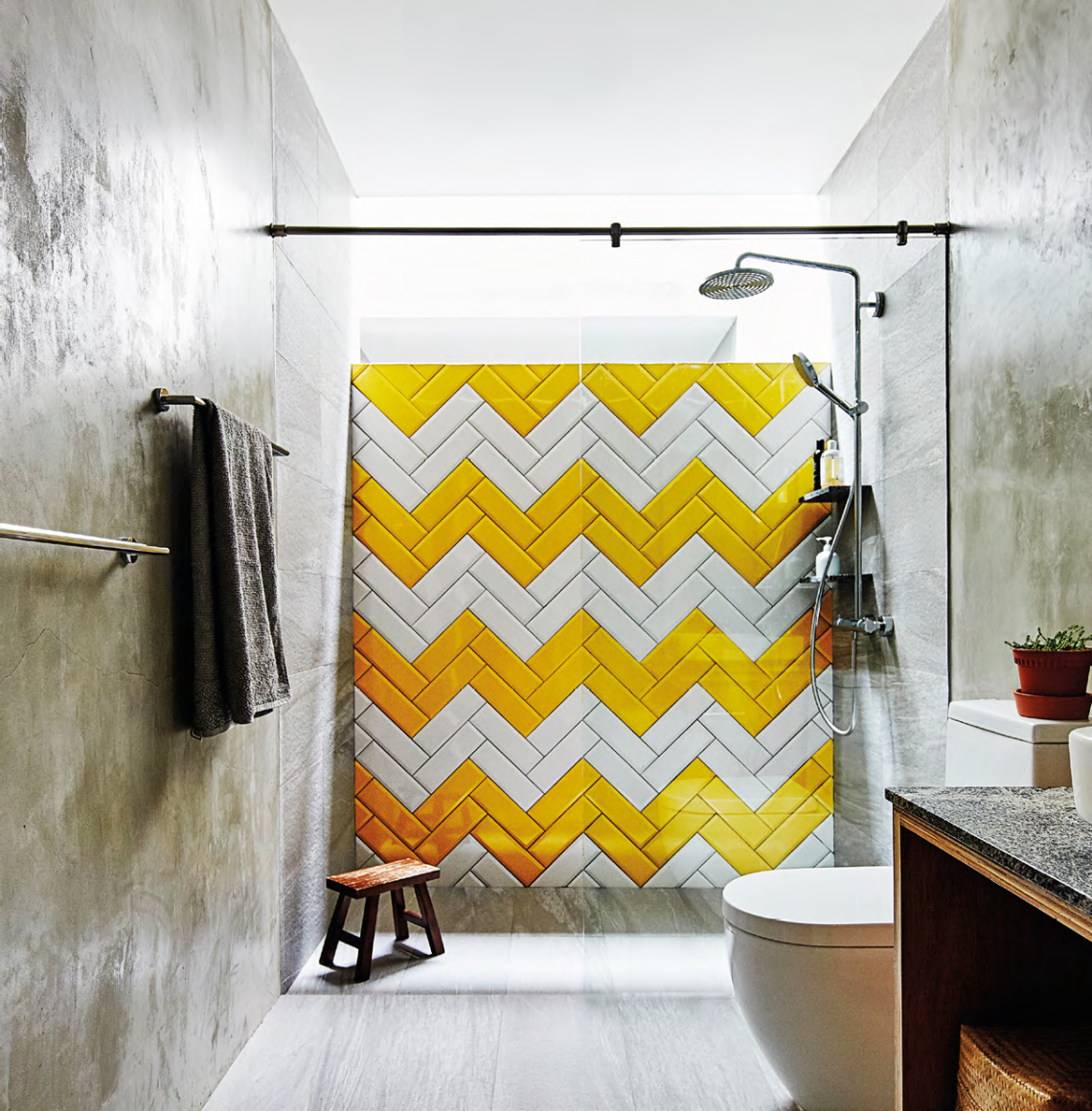Not sure how to get started on renovating your bathroom, or how much it’ll cost? Here’s a handy checklist to run through before embarking on your redesign.
What are some of the bathroom’s existing problems?
Be it resale or Build-to-Order flats, it’s important to check for leak stains or spalling on the ceiling, as well as hollow tiles and punctured grouts that may result in tile popping. Your flush and taps should have good water flow and drainage holes should not be clogged. Water must drain quickly, too – your bathroom floor ought to have a subtle slope that helps water move easily into the drain. Knowing these flaws helps determine the works and cost needed, and who should fix them.

It’s important to check for leak stains or spalling on the ceiling.

Built-ins are easier to clean and more space-saving.
How do I decide between built-in or stand-alone bathtubs?
Built-ins are easier to clean and more space-saving, while most stand-alone tubs – due to exposed fittings – are easier to service.
Decide on which model you want early on, to plan for the storage or wall niches surrounding the tub as well as calculate the extra tiles required to clad the builtin tub. Information on the size and shape of the tub is necessary for any re-piping, too. “When choosing a standalone tub, you must consider its bath filler. Wall-mounted and free-standing fillers need extra piping along the wall or underneath the floor,” says Gani Atmadiredja, managing director of W. Atelier.
What does it mean to waterproof a bathroom?
As bathrooms are constantly wet, it’s crucial to prevent leaking to the neighbour below you. Waterproofing, where a water-tight rubbery material is applied to the concrete, prevents water from seeping through. Some areas may even require multiple layers for extra precaution – the thicker the better! Waterproofing is done before tiling and grouting, and on both floors and walls. The latter is especially important for bathrooms with concrete walls, as too much moisture will cause cracking

Frosted or tinted glass doors and screens offer more privacy.
What door and wall options do I have?
A typical bathroom will require one main door and perhaps a glass shower screen. Frosted or tinted glass doors and screens offer more privacy, while louvre doors ensure ventilation. Small spaces benefit from mirrored, bifold and/or sliding doors. For bathrooms with glass walls, installing blinds means more privacy.
Tile-cladded walls are the most common and easy to maintain, though many homeowners opt for moisture-resistant wallcoverings and paint, too. “For glass, stone and man-made materials such as quartz or Fenix NTM (the water- and scratchproof nanotech material by local brand EDL) large pieces are required; this gives you a sleeker look, but is costlier,” says Adrian Heng of Ottimo Spazi.
Is hacking necessary?
If your bathroom is leaking to the floor below you, or the old tiles are falling apart, hacking is necessary. The bathroom will require re-waterproofing, re-tiling and re-grouting. “To ensure your tiles last a long time, invest in quality materials. The surface area of most bathrooms is small, so the extra cost will not be too hefty,” says Adrian.
Hacking walls is also required when expanding bathrooms. Private-property owners can expand both wet and dry areas, provided they are adequately waterproofed. “HDB homeowners can have larger bathrooms, too, but the extra space can only be used as the dry area – for sinks or shelves. Sinks can also be relocated outside the bathroom, but that requires (chargeable) re-piping,” says Adrian.

Sinks can be relocated outside the bathroom.
Is my bathroom suitable for a wall-hung WC?
There are two types of WCs: A floor-standing model and a wall-hung model. Many prefer wall-hung models for its sleek look and concealed cistern, though not all bathrooms can accommodate one; wall-hung WCs strictly require a P-trap – the term used for drainage outlets located on the wall instead of the floor. If you do not have a P-trap, and can only choose a floor-standing model, you can conceal its cistern behind a false wall or ledge.
Whichever the model, ensure there is enough distance and walking space between the WC and opened doors.
How much will one bathroom cost?
“An 80sqf bathroom may cost you $6,000 and above. This includes standard cabinetry, tiling, and wet works – including the costs of tiles and removal and reattachment of an existing sink. The price will differ depending on the type of tiles, whether you need false walls and ceiling, relocation of the sink, and a designer fee,” says Raymond Seow of Free Space Intent. Arjan Twilhaar of Aiden T adds: “For the average fourroom BTO bathroom, the tiling work – based on a $4 tile – will cost between $4,000 and $4,800. Hacking of existing tiles may cost up to $1,500, though this can only be done after the fiveyear warranty. Boxing up of pipes and ceiling works are about $300 each, while a vanity cabinet and countertop costs $900.”
How do we keep costs down?
Hexagonal, subway and mosaic tiles require a more labourintensive installation, so save money by opting for 30cm by 30cm, or 30cm by 60cm tiles. The more tile variations in one bathroom, the costlier it will be. Overlaying of tiles and exposed plumbing do not require hacking or plumbing works, and are more affordable.
“Many homeowners look for more economical fittings. Since these items are not easily replaced, it is good to buy quality products that will last many years and save you the hassle of constant repairs,” shares Arjan.

Avoid mould and mildew by keeping your bathroom windows open.

There needs to be a 2cm drop (at the least) in the bathroom flooring to avoid leaks into rooms.
What are some common bathroom problems, and how do we avoid them?
Regularly clearing the floor and sink filters of hair and gunk will prevent your drain from clogging. Next, avoid mould and mildew by letting fresh air and sunlight in; keep your bathroom windows open – frosted glass windows increase privacy – or install a ventilation fan.
Although wiping down the countertop and floor help keep the bathroom dry, you can minimise splashing at the sink by ensuring the right distance between tap spout and sink. These depend on size, depth and where both tap and sink sit, which are chosen based on your usage and aesthetic preferences.
Hansgrohe and Axor are two brands that offer guidelines for users to see which of their mixers will match basins from manufacturers.
Lastly, to avoid water from spilling out into the living room or bedroom, there needs to be a 2cm drop (at the least) in the bathroom flooring. Homeowners can also install an additional kerb to contain water.

All glass screens should be tempered.
What are some safety precautions to note?
“Sockets are not allowed in HDB bathrooms, but private-property owners can opt for an 110V point for shavers and builtin hairdryers. All glass screens should at least be tempered, or even better, laminated. I prefer waterproof materials, too, from lighting fixtures to the moisture-resistant calcium silicate board for drop ceilings,” says Arjan. If your water heater is producing water that is hotter than usual, or the pressure relief valve is leaking, these are signs of a defective thermostat and valve.
Additionally, even though your heater switch is outside the bathroom, bad wiring may still cause electric shocks. Ensure electrical works, including the installation of water heaters or replacing of switches, are done by a licensed worker. Check with the Energy Market Authority through its website (
www.ema.gov.sg).





































